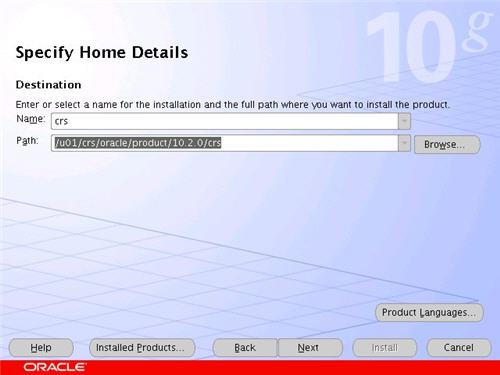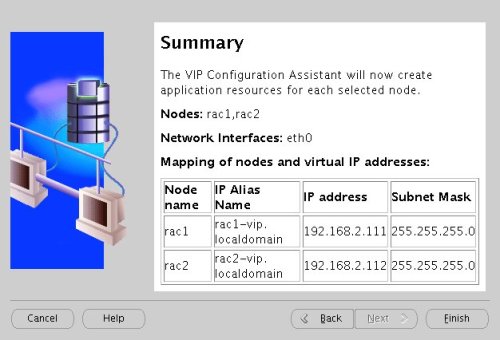Oracle 10g RAC On Linux Using NFS
Oracle 10g RAC On Linux Using NFS
This article describes the installation of Oracle 10g release 2 (10.2.0.1) RAC on Linux (Oracle Enterprise Linux 4.5) using NFS to provide the shared storage.
- Introduction
- Download Software
- Operating System Installation
- Oracle Installation Prerequisites
- Create Shared Disks
- Install the Clusterware Software
- Install the Database Software
- Create a Database using the DBCA
- TNS Configuration
- Check the Status of the RAC
- Direct and Asynchronous I/O
Introduction
NFS is an abbreviation of Network File System, a platform independent technology created by Sun Microsystems that allows shared access to files stored on computers via an interface called the Virtual File System (VFS) that runs on top of TCP/IP. Computers that share files are considered NFS servers, while those that access shared files are considered NFS clients. An individual computer can be either an NFS server, a NFS client or both.
We can use NFS to provide shared storage for a RAC installation. In a production environment we would expect the NFS server to be a NAS, but for testing it can just as easily be another server, or even one of the RAC nodes itself.
To cut costs, this articles uses one of the RAC nodes as the source of the shared storage. Obviously, this means if that node goes down the whole database is lost, so it's not a sensible idea to do this if you are testing high availability. If you have access to a NAS or a third server you can easily use that for the shared storage, making the whole solution much more resilient. Whichever route you take, the fundamentals of the installation are the same.
This article was inspired by the blog postings of Kevin Closson.
Download Software
Download the following software.
- Oracle Enterprise Linux
- Oracle 10g (10.2.0.1) CRS and DB software
Operating System Installation
This article uses Oracle Enterprise Linux 4.5, but it will work equally well on CentOS 4 or Red Hat Enterprise Linux (RHEL) 4. A general pictorial guide to the operating system installation can be found here. More specifically, it should be a server installation with a minimum of 2G swap, firewall and secure Linux disabled and the following package groups installed:
- X Window System
- GNOME Desktop Environment
- Editors
- Graphical Internet
- Server Configuration Tools
- FTP Server
- Development Tools
- Legacy Software Development
- Administration Tools
- System Tools
To be consistent with the rest of the article, the following information should be set during the installation.
RAC1.
- hostname: rac1.localdomain
- IP Address eth0: 192.168.2.101 (public address)
- Default Gateway eth0: 192.168.2.1 (public address)
- IP Address eth1: 192.168.0.101 (private address)
- Default Gateway eth1: none
RAC2.
- hostname: rac2.localdomain
- IP Address eth0: 192.168.2.102 (public address)
- Default Gateway eth0: 192.168.2.1 (public address)
- IP Address eth1: 192.168.0.102 (private address)
- Default Gateway eth1: none
You are free to change the IP addresses to suit your network, but remember to stay consistent with those adjustments throughout the rest of the article.
Once the basic installation is complete, install the following packages whilst logged in as the root user.
# From Oracle Enterprise Linux 4.5 Disk 1 cd /media/cdrecorder/CentOS/RPMS rpm -Uvh setarch-1* rpm -Uvh compat-libstdc++-33-3* rpm -Uvh make-3* rpm -Uvh glibc-2* cd / eject # From Oracle Enterprise Linux 4.5 Disk 2 cd /media/cdrecorder/CentOS/RPMS rpm -Uvh openmotif-2* rpm -Uvh compat-db-4* rpm -Uvh gcc-3* cd / eject # From Oracle Enterprise Linux 4.5 Disk 3 cd /media/cdrecorder/CentOS/RPMS rpm -Uvh libaio-0* rpm -Uvh rsh-* rpm -Uvh compat-gcc-32-3* rpm -Uvh compat-gcc-32-c++-3* rpm -Uvh openmotif21* cd / eject
Oracle Installation Prerequisites
Perform the following steps whilst logged into the RAC1 virtual machine as the root user.
The "/etc/hosts" file must contain the following information.
127.0.0.1 localhost.localdomain localhost # Public 192.168.2.101 rac1.localdomain rac1 192.168.2.102 rac2.localdomain rac2 #Private 192.168.0.101 rac1-priv.localdomain rac1-priv 192.168.0.102 rac2-priv.localdomain rac2-priv #Virtual 192.168.2.111 rac1-vip.localdomain rac1-vip 192.168.2.112 rac2-vip.localdomain rac2-vip #NAS 192.168.2.101 nas1.localdomain nas1
Notice that the NAS1 entry is actually pointing to the RAC1 node. If you are using a real NAS or a third server to provide your shared storage put the correct IP address into the file.
Add the following lines to the "/etc/sysctl.conf" file.
kernel.shmall = 2097152 kernel.shmmax = 2147483648 kernel.shmmni = 4096 # semaphores: semmsl, semmns, semopm, semmni kernel.sem = 250 32000 100 128 #fs.file-max = 65536 net.ipv4.ip_local_port_range = 1024 65000 #net.core.rmem_default=262144 #net.core.rmem_max=262144 #net.core.wmem_default=262144 #net.core.wmem_max=262144 # Additional and amended parameters suggested by Kevin Closson net.core.rmem_default = 524288 net.core.wmem_default = 524288 net.core.rmem_max = 16777216 net.core.wmem_max = 16777216 net.ipv4.ipfrag_high_thresh=524288 net.ipv4.ipfrag_low_thresh=393216 net.ipv4.tcp_rmem=4096 524288 16777216 net.ipv4.tcp_wmem=4096 524288 16777216 net.ipv4.tcp_timestamps=0 net.ipv4.tcp_sack=0 net.ipv4.tcp_window_scaling=1 net.core.optmem_max=524287 net.core.netdev_max_backlog=2500 sunrpc.tcp_slot_table_entries=128 sunrpc.udp_slot_table_entries=128 net.ipv4.tcp_mem=16384 16384 16384
Run the following command to change the current kernel parameters.
/sbin/sysctl -p
Add the following lines to the "/etc/security/limits.conf" file.
* soft nproc 2047 * hard nproc 16384 * soft nofile 1024 * hard nofile 65536
Add the following line to the "/etc/pam.d/login" file, if it does not already exist.
session required pam_limits.so
Disable secure linux by editing the "/etc/selinux/config" file, making sure the SELINUX flag is set as follows.
SELINUX=disabled
Alternatively, this alteration can be done using the GUI tool (Applications > System Settings > Security Level). Click on the SELinux tab and disable the feature.
Set the hangcheck kernel module parameters by adding the following line to the "/etc/modprobe.conf" file.
options hangcheck-timer hangcheck_tick=30 hangcheck_margin=180
To load the module immediately, execute "modprobe -v hangcheck-timer".
Create the new groups and users.
groupadd oinstall groupadd dba groupadd oper useradd -g oinstall -G dba oracle passwd oracle
During the installation, both RSH and RSH-Server were installed. Enable remote shell and rlogin by doing the following.
chkconfig rsh on chkconfig rlogin on service xinetd reload
Create the "/etc/hosts.equiv" file as the root user.
touch /etc/hosts.equiv chmod 600 /etc/hosts.equiv chown root:root /etc/hosts.equiv
Edit the "/etc/hosts.equiv" file to include all the RAC nodes:
+rac1 oracle +rac2 oracle +rac1-priv oracle +rac2-priv oracle
Login as the oracle user and add the following lines at the end of the ".bash_profile" file.
# Oracle Settings
TMP=/tmp; export TMP
TMPDIR=$TMP; export TMPDIR
ORACLE_BASE=/u01/app/oracle; export ORACLE_BASE
ORACLE_HOME=$ORACLE_BASE/product/10.2.0/db_1; export ORACLE_HOME
ORACLE_SID=RAC1; export ORACLE_SID
ORACLE_TERM=xterm; export ORACLE_TERM
PATH=/usr/sbin:$PATH; export PATH
PATH=$ORACLE_HOME/bin:$PATH; export PATH
LD_LIBRARY_PATH=$ORACLE_HOME/lib:/lib:/usr/lib; export LD_LIBRARY_PATH
CLASSPATH=$ORACLE_HOME/JRE:$ORACLE_HOME/jlib:$ORACLE_HOME/rdbms/jlib; export CLASSPATH
if [ $USER = "oracle" ]; then
if [ $SHELL = "/bin/ksh" ]; then
ulimit -p 16384
ulimit -n 65536
else
ulimit -u 16384 -n 65536
fi
fi
Remember to set the ORACLE_SID to RAC2 on the second node.
Create Shared Disks
First we need to set up some NFS shares. In this case we will do this on the RAC1 node, but you can do the on a NAS or a third server if you have one available. On the RAC1 node create the following directories.
mkdir /share1 mkdir /share2
Add the following lines to the "/etc/exports" file.
/share1 *(rw,sync,no_wdelay,insecure_locks,no_root_squash) /share2 *(rw,sync,no_wdelay,insecure_locks,no_root_squash)
Run the following command to export the NFS shares.
chkconfig nfs on service nfs restart
On both RAC1 and RAC2 create some mount points to mount the NFS shares to.
mkdir /u01 mkdir /u02
Add the following lines to the "/etc/fstab" file. The mount options are suggestions from Kevin Closson.
nas1:/share1 /u01 nfs rw,bg,hard,nointr,tcp,vers=3,timeo=300,rsize=32768,wsize=32768,actimeo=0 0 0 nas1:/share2 /u02 nfs rw,bg,hard,nointr,tcp,vers=3,timeo=300,rsize=32768,wsize=32768,actimeo=0 0 0
Mount the NFS shares on both servers.
mount /u01 mount /u02
Create the shared CRS Configuration and Voting Disk files.
touch /u01/crs_configuration touch /u01/voting_disk
Create the directories in which the Oracle software will be installed.
mkdir -p /u01/crs/oracle/product/10.2.0/crs mkdir -p /u01/app/oracle/product/10.2.0/db_1 mkdir -p /u01/oradata chown -R oracle:oinstall /u01 /u02
Install the Clusterware Software
Place the clusterware and database software in the "/u02" directory and unzip it.
cd /u02 unzip 10201_clusterware_linux32.zip unzip 10201_database_linux32.zip
Login to RAC1 as the oracle user and start the Oracle installer.
cd /u02/clusterware ./runInstaller
On the "Welcome" screen, click the "Next" button.

Accept the default inventory location by clicking the "Next" button.

Enter the appropriate name and path for the Oracle Home and click the "Next" button.

Wait while the prerequisite checks are done. If you have any failures correct them and retry the tests before clicking the "Next" button.

The "Specify Cluster Configuration" screen shows only the RAC1 node in the cluster. Click the "Add" button to continue.

Enter the details for the RAC2 node and click the "OK" button.

Click the "Next" button to continue.

The "Specific Network Interface Usage" screen defines how each network interface will be used. Highlight the "eth0" interface and click the "Edit" button.

Set the "eht0" interface type to "Public" and click the "OK" button.

Leave the "eth1" interface as private and click the "Next" button.

Click the "External Redundancy" option, enter "/u01/ocr_configuration" as the OCR Location and click the "Next" button. To have greater redundancy we would need to define another shared disk for an alternate location.

Click the "External Redundancy" option, enter "/u01/voting_disk" as the Voting Disk Location and click the "Next" button. To have greater redundancy we would need to define another shared disk for an alternate location.

On the "Summary" screen, click the "Install" button to continue.

Wait while the installation takes place.

Once the install is complete, run the orainstRoot.sh and root.sh scripts on both nodes as directed on the following screen.

The output from the orainstRoot.sh file should look something like that listed below.
# cd /u01/app/oracle/oraInventory # ./orainstRoot.sh Changing permissions of /u01/app/oracle/oraInventory to 770. Changing groupname of /u01/app/oracle/oraInventory to oinstall. The execution of the script is complete #
The output of the root.sh will vary a little depending on the node it is run on. The following text is the output from the RAC1 node.
# cd /u01/crs/oracle/product/10.2.0/crs
# ./root.sh
WARNING: directory '/u01/crs/oracle/product/10.2.0' is not owned by root
WARNING: directory '/u01/crs/oracle/product' is not owned by root
WARNING: directory '/u01/crs/oracle' is not owned by root
WARNING: directory '/u01/crs' is not owned by root
WARNING: directory '/u01' is not owned by root
Checking to see if Oracle CRS stack is already configured
/etc/oracle does not exist. Creating it now.
Setting the permissions on OCR backup directory
Setting up NS directories
Oracle Cluster Registry configuration upgraded successfully
WARNING: directory '/u01/crs/oracle/product/10.2.0' is not owned by root
WARNING: directory '/u01/crs/oracle/product' is not owned by root
WARNING: directory '/u01/crs/oracle' is not owned by root
WARNING: directory '/u01/crs' is not owned by root
WARNING: directory '/u01' is not owned by root
assigning default hostname rac1 for node 1.
assigning default hostname rac2 for node 2.
Successfully accumulated necessary OCR keys.
Using ports: CSS=49895 CRS=49896 EVMC=49898 and EVMR=49897.
node <nodenumber>: <nodename> <private interconnect name> <hostname>
node 1: rac1 rac1-priv rac1
node 2: rac2 rac2-priv rac2
Creating OCR keys for user 'root', privgrp 'root'..
Operation successful.
Now formatting voting device: /u01/voting_disk
Format of 1 voting devices complete.
Startup will be queued to init within 90 seconds.
Adding daemons to inittab
Expecting the CRS daemons to be up within 600 seconds.
CSS is active on these nodes.
rac1
CSS is inactive on these nodes.
rac2
Local node checking complete.
Run root.sh on remaining nodes to start CRS daemons.
#
Ignore the directory ownership warnings. We should really use a separate directory structure for the clusterware so it can be owned by the root user, but it has little effect on the finished results.
The output from the RAC2 node is listed below.
# /u01/crs/oracle/product/10.2.0/crs
# ./root.sh
WARNING: directory '/u01/crs/oracle/product/10.2.0' is not owned by root
WARNING: directory '/u01/crs/oracle/product' is not owned by root
WARNING: directory '/u01/crs/oracle' is not owned by root
WARNING: directory '/u01/crs' is not owned by root
WARNING: directory '/u01' is not owned by root
Checking to see if Oracle CRS stack is already configured
/etc/oracle does not exist. Creating it now.
Setting the permissions on OCR backup directory
Setting up NS directories
Oracle Cluster Registry configuration upgraded successfully
WARNING: directory '/u01/crs/oracle/product/10.2.0' is not owned by root
WARNING: directory '/u01/crs/oracle/product' is not owned by root
WARNING: directory '/u01/crs/oracle' is not owned by root
WARNING: directory '/u01/crs' is not owned by root
WARNING: directory '/u01' is not owned by root
clscfg: EXISTING configuration version 3 detected.
clscfg: version 3 is 10G Release 2.
assigning default hostname rac1 for node 1.
assigning default hostname rac2 for node 2.
Successfully accumulated necessary OCR keys.
Using ports: CSS=49895 CRS=49896 EVMC=49898 and EVMR=49897.
node <nodenumber>: <nodename> <private interconnect name> <hostname>
node 1: rac1 rac1-priv rac1
node 2: rac2 rac2-priv rac2
clscfg: Arguments check out successfully.
NO KEYS WERE WRITTEN. Supply -force parameter to override.
-force is destructive and will destroy any previous cluster
configuration.
Oracle Cluster Registry for cluster has already been initialized
Startup will be queued to init within 90 seconds.
Adding daemons to inittab
Expecting the CRS daemons to be up within 600 seconds.
CSS is active on these nodes.
rac1
rac2
CSS is active on all nodes.
Waiting for the Oracle CRSD and EVMD to start
Waiting for the Oracle CRSD and EVMD to start
Waiting for the Oracle CRSD and EVMD to start
Waiting for the Oracle CRSD and EVMD to start
Waiting for the Oracle CRSD and EVMD to start
Waiting for the Oracle CRSD and EVMD to start
Waiting for the Oracle CRSD and EVMD to start
Oracle CRS stack installed and running under init(1M)
Running vipca(silent) for configuring nodeapps
The given interface(s), "eth0" is not public. Public interfaces should be used to configure virtual IPs.
#
Here you can see that some of the configuration steps are omitted as they were done by the first node. In addition, the final part of the script ran the Virtual IP Configuration Assistant (VIPCA) in silent mode, but it failed. This is because my public IP addresses are actually within the "192.168.255.255" range which is a private IP range. If you were using "legal" IP addresses you would not see this and you could ignore the following VIPCA steps.
Run the VIPCA manually as the root user on the RAC2 node using the following command.
# cd /u01/crs/oracle/product/10.2.0/crs/bin # ./vipca
Click the "Next" button on the VIPCA welcome screen.

Highlight the "eth0" interface and click the "Next" button.

Enter the vitual IP alias and address for each node. Once you enter the first alias, the remaining values should default automatically. Click the "Next" button to continue.

Accept the summary information by clicking the "Finish" button.

Wait until the configuration is complete, then click the "OK" button.

Accept the VIPCA results by clicking the "Exit" button.

You should now return to the "Execute Configuration Scripts" screen on RAC1 and click the "OK" button.

Wait for the configuration assistants to complete.

When the installation is complete, click the "Exit" button to leave the installer.

The clusterware installation is now complete.
Install the Database Software
Login to RAC1 as the oracle user and start the Oracle installer.
cd /u02/database ./runInstaller
On the "Welcome" screen, click the "Next" button.

Select the "Enterprise Edition" option and click the "Next" button.